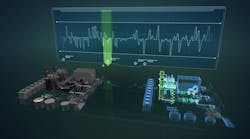A digital twin is a virtualized replica of an actual facility or plant, either hosted on premises or in the cloud. It draws data from a number of sources, including real-time control systems, asset management systems, historians, records of employee/customer interactions and other sources. With IoT implementations providing more and more data, high-fidelity digital twins are becoming easier to create and maintain.
Companies use these digital twins to understand their world better by modeling different scenarios, with a goal of making proactive instead of reactive decisions.They do this by running simulations and what-if scenarios within the digital twin, and using the results to improve operations and employee skills.
Manufacturers tend to use digital twins to improve operations such as plant processes, and to optimize supply chains.
Digital twins are most beneficial when employed to improve ongoing operations and train employees, but they can also be used to test new procedures and products in the virtual world before introduction to the real world. This reduces risk because mistakes can be made and corrected offline instead of during actual production or in a working facility with live customers.
Improving AI
Digital twins can provide the high-quality inputs needed to create models of operations. Artificial intelligence (AI), machine learning and other advanced technologies use these models to suggest improvements to operations. Once operations are improved, the digital twin also improves and provides higher-quality inputs to models, which are then used by advanced technologies to suggest further improvement.
One example is a plant producing refined petrochemical products. These plants have many complex processes, most of which can be simulated in a virtual twin. Any improvements must be tested as thoroughly as possible in a simulated environment before real-world implementation because these processes are often dangerous, with errors resulting in reduced production in the best case, extended downtime in other instances, and safety incidents in the worst case.
Digital twins allow experts to examine operations either onsite or from afar. Some plants may have the required expertise onsite, while other companies may rely on experts located at headquarters. Because many of these processes involve complex machinery such as reactors, the assistance of suppliers is often required, which can be facilitated by making a cloud-based virtual twin available to these and other resources outside the company.
Once a proposed improvement has been analyzed and tested by internal and external experts, a new procedure must often be created for the control room operators running the plant. This procedure can be tested using the virtual twin to train operators before actual implementation.
For example, an operation which had previously been run in a manual mode by operators because a measurement was not available is now being transitioned to automatic by using an input created by an AI-based technique called inferred measurement. This inferred measurement is made based on a combination of related actual measurements, and is used as the process variable in a closed-loop controller.
This is a significant change for plant operators, and running it on a digital twin can create trust in the inferred measurement and the resulting automatic, closed-loop control. Without this testing and simulation, operators have been known to reject transitions from manual to automatic control, or to implement these improvements incorrectly.
One caveat when implementing digital twins is to avoid excess computational and operational complexity. Computational complexity can tax hardware resources, and operational complexity can overwhelm the personnel charged with creating and maintaining the models. As with any advanced software tool, a point of diminishing returns can be reached where adding new tools, enhancements and features results in only marginal improvements while greatly increasing complexity.
But when implemented correctly, a digital twin can be a key part of any IoT implementation, as it enables companies to simulate processes and improve operations. Leveraging digital twins also allows companies to train new employees and bring them up to speed faster, while easing the introduction of improvements.
Jason Andersen is vice president of business line management and is responsible for setting the product roadmaps and go-to-market strategies for Stratus Products and Services.




